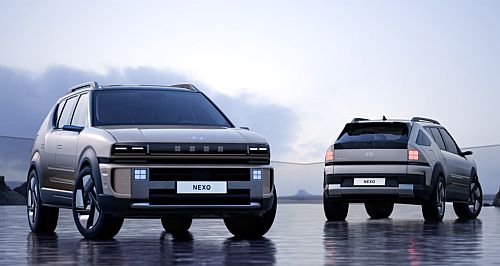Make / Model Search
Future models - Hyundai - NEXOSecond-gen Hyundai Nexo hydrogen SUV revealedMore assertive styling, greater range and considerably more power for renewed Nexo3 Apr 2025 By TOM BAKER HYUNDAI has revealed its second-generation Nexo hydrogen fuel cell electric vehicle (FCEV) with the restyled SUV packing a suite of improvements to the performance, efficiency and range of its powertrain, as well as a number of brand-first design cues and technologies.
Despite its ultra-niche status and fuel type, the new Nexo has already been confirmed for Australia with Hyundai Motor Company Australia (HMCA) public relations senior manager Guido Schenken telling GoAuto that a local launch is slated for the first half of 2026.
The incoming vehicle will replace the current first-generation Nexo that was revealed in 2018 and was released in Australia to a select group of government and corporate operators in 2021.
Australian roads currently host 35 first-generation Nexos, with 20 leased by the Australian Capital Territory government and a further five driven by Queensland government employees. The remainder are split between Woodside, Atco Gas, the Embassy of Korea, and HMCA itself.
Key among the updates to the Nexo is a significantly uprated FCEV powertrain with more efficient inverter. While the outgoing Nexo produced a system total of 135kW of power, the new model now delivers 190kW, enabling a reduced 0-100km/h sprint of 7.8 seconds (-1.4sec). A larger battery assists with performance and energy buffering.
Hydrogen storage capacity has increased by five per cent to 6.69kg. Together with drivetrain efficiency improvements courtesy of a new motor (and the aforementioned revised inverter) the second-generation Nexo is expected to achieve a WLTP range of more than 700km.
That would represent a five to six per cent improvement over the current model’s 666km (WLTP) driving range.
Despite these upgrades, Hyundai has retained the Nexo’s core fuel cell system architecture. A principal benefit of FCEV technology remains rapid refuelling potential—if you can find a station. Replenishing a full tank of hydrogen takes around five minutes depending on station pressure and reserves.
While the refuelling time remains comparable to that of internal combustion vehicles, access to hydrogen infrastructure continues to be a significant limitation for FCEVs—particularly in Australia.
HMCA says there are nine operational hydrogen refuellers nationwide, located in Sydney, Canberra, Brisbane and Perth, while there are two stations in Melbourne. An additional eight facilities are said to be in development and an upgrade of HMCA’s own Sydney-based hydrogen production facility.
The site is capable of generating up to 20kg of green hydrogen per day using electrolysis powered by solar energy. In optimal conditions this would be sufficient to refuel three Nexos.
It is not yet clear whether the new Nexo will continue as a lease-only vehicle in Australia or if HMCA will offer the SUV for outright sale. Pricing for the previous-generation Nexo was never disclosed, but GoAuto understands a purchase price would have exceeded $100,000 before on-road costs.
Exterior styling for the second-generation Nexo has undergone a significant redesign. Hyundai has replaced the first-generation car’s smooth and conservative aesthetic with a more distinctive, angular design. Design elements reference Hyundai’s latest design language, dubbed “Art of Steel”, and incorporate retro crossover themes in the C- and D-pillar region.
Standard exterior features, at least for the Korean market, include 18-inch wheels, four-dot signature LED headlights, and digital side mirrors to improve aerodynamics. A three-layer paint option called Goyo Copper Pearl shifts hue under different lighting.
The interior benefits from a range of enhancements designed to bring the Nexo in line with Hyundai’s premium electric vehicle offering. Front occupants enjoy ‘relaxation’ seats trimmed in artificial leather upholstery with heating and cooling functions while a curved infotainment display is fitted.
Despite the modest uptake of FCEVs globally, South Korea remains an outlier, and the Nexo is an important model for Hyundai in its home market—as well as one of the few ongoing FCEV passenger vehicle programs. Although volumes tapered to around 4000 in 2023 and 3000 in 2022, Hyundai sold over 10,000 examples of Nexo in 2022.
The company’s decision to invest in a substantial redesign of the Nexo suggests that, despite headwinds for the fuel type, Hyundai views FCEVs as retaining strategic value in markets where hydrogen refuelling might be viable—both for commercial and passenger applications.  Read more2nd of April 2025  Hyundai Insteroid teases cheaper "N" EVAWD Ioniq 5 N running gear is disguised beneath reprise of 1980s rally-car styling17th of January 2025  Hyundai Kona, Ioniq 6 retail offers availableDiscounts of up to $20,000 on electric-powered Hyundai Kona and Ioniq 6 modelsAll future modelsMotor industry news |
Click to shareHyundai modelsResearch Hyundai All future modelsMotor industry news |



 Alfa Romeo
Alfa Romeo Abarth
Abarth Audi
Audi Aston Martin
Aston Martin BMW
BMW Bentley
Bentley Ferrari
Ferrari Chevrolet
Chevrolet Ford
Ford Fiat
Fiat GWM
GWM Foton
Foton Hyundai
Hyundai Honda
Honda Jaguar
Jaguar Isuzu
Isuzu Kia
Kia Jeep
Jeep Land Rover
Land Rover Lamborghini
Lamborghini Maserati
Maserati Lexus
Lexus McLaren
McLaren Mazda
Mazda Mercedes-Benz
Mercedes-Benz Mitsubishi
Mitsubishi Mini
Mini Peugeot
Peugeot Nissan
Nissan Ram
Ram Porsche
Porsche Rolls-Royce
Rolls-Royce Smart
Smart Skoda
Skoda Suzuki
Suzuki Subaru
Subaru Toyota
Toyota Tesla
Tesla Volvo
Volvo Zeekr
Zeekr







Facebook Twitter Instagram